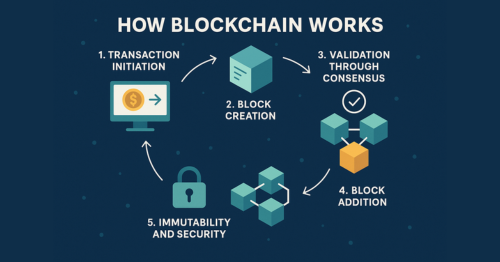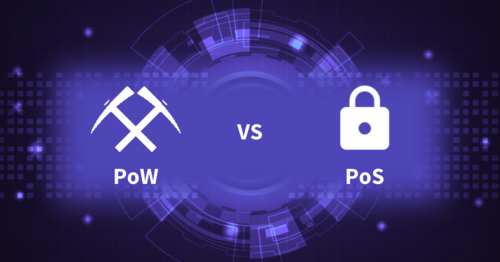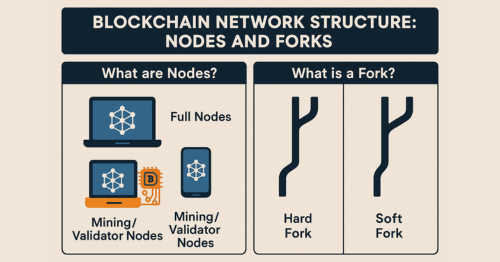
Introduction to Blockchain Technology
Blockchain Fundamentals: Blockchain is like a digital notebook that’s copied across many computers. No one owns it completely, and everyone has access to the same up-to-date information. Unlike traditional databases managed by centralized authorities (like banks or governments), blockchain is trustless, transparent, and tamper-resistant.

Each transaction or piece of data is recorded in a block, and these blocks are linked together chronologically using cryptographic hashes, forming a “chain” of blocks, hence the name blockchain. Once entered into the blockchain, the data becomes tamper-proof; any changes or deletions require approval from the entire network, ensuring transparency and integrity.
This technology underpins cryptocurrencies like Bitcoin and Ethereum, but its potential applications span across industries, from supply chain to healthcare and beyond.
Brief History of Blockchain Technology
Blockchain’s roots go back to the 1990s:

- 1991 – Stuart Haber and W. Scott Stornetta introduced a cryptographically secure chain of blocks for document timestamping.
- 2008 – A person or group using the pseudonym Satoshi Nakamoto published the famous whitepaper titled “Bitcoin: A Peer-to-Peer Electronic Cash System.” This was the first practical implementation of blockchain.
- 2009 – Bitcoin network goes live. The Genesis Block is mined.
- 2015 – Ethereum launches with smart contract capabilities, expanding blockchain use cases beyond digital currency.
Since then, blockchain has evolved rapidly, powering DeFi (Decentralized Finance), NFTs, DAOs (Decentralized Autonomous Organizations), and enterprise solutions.
How Does Blockchain Work?

Understanding blockchain mechanics is key to grasping its transformative power. Here’s a breakdown:
1. Transaction Initiation
A transaction begins when a user decides to send cryptocurrency, which could be to pay someone, transfer funds, or make a purchase using digital coins. A user initiates a transaction, such as sending cryptocurrency.
2. Block Creation
The transaction is combined with several others and packaged into a new unit called a block. This block contains:
- Transaction data
- Timestamp
- Hash of the previous block
- A unique nonce (number used once)
3. Validation Through Consensus
Before the new block is added to the chain, network participants (called nodes) must verify its validity. This is done through consensus mechanisms (explained in the next section).
4. Block Addition
Once the block is approved, it becomes a permanent part of the blockchain. Then, everyone in the network updates their version of the record to include this new block. Once validated, the block is added to the blockchain. Every participant updates their copy of the ledger.
5. Immutability and Security
Each block is securely connected to the one before it using special codes, creating a chain that can’t be broken or changed. Altering any information would require re-mining all subsequent blocks, a nearly impossible feat on a decentralized network.
Blockchain Consensus Mechanisms: PoW vs. PoS

Blockchain networks rely on consensus mechanisms to agree on the validity of transactions without a central authority.
Proof of Work (PoW)
- Used by: Bitcoin, Litecoin
- Process: Miners compete to solve a difficult puzzle, and whoever solves it first earns the right to add the next block to the blockchain and receive a reward.
- Energy Consumption: High
- Security: Very secure but resource-intensive
In PoW, the first miner to solve the puzzle earns the right to add the block and is rewarded with cryptocurrency. However, this process consumes significant computational power and electricity.
Proof of Stake (PoS)
- Used by: Ethereum (post-merge), Cardano
- Process: Validators are selected based on how many tokens they lock up as a guarantee, showing their commitment to keeping the network secure.
- Energy Consumption: Very low
- Security: Secure and scalable
PoS promotes eco-friendly blockchain operations by eliminating the mining process and rewarding validators based on their stake and reliability.
Blockchain Network Structure: Nodes and Forks

What are Nodes?
A node is any computer connected to the blockchain network that helps store, share, or verify data within the system. There are several types:
- Full Nodes: Keep an entire copy of the blockchain and are responsible for checking and confirming every transaction that happens on the network.
- Light Nodes: Hold only a small portion of the blockchain and depend on full nodes to access and verify complete data when needed.
- Mining/Validator Nodes: Add new blocks (via PoW or PoS).
Nodes maintain the health and decentralization of the network.
What is a Fork?
A fork occurs when there’s a split in the blockchain protocol or path. There are two primary types:
- Hard Fork: A permanent divergence requiring all participants to upgrade (e.g., Bitcoin Cash split from Bitcoin).
- Soft Fork: It is a gentle update to the blockchain rules that works with older versions, so not every node needs to upgrade to stay connected.
Forks often occur due to community disagreements or to implement new features.
Blockchain Use Cases and Limitations

Key Use Cases
- Cryptocurrency: Enables peer-to-peer digital payments without banks.
- Smart Contracts: Automates legal agreements without intermediaries.
- Supply Chain Tracking: Enhances transparency from production to delivery.
- Digital Identity: Empowers individuals with self-sovereign ID systems.
- Voting Systems: Offers tamper-proof, verifiable digital voting.
- Healthcare: Safely stores patient records and streamlines data sharing.
- Real Estate & Land Registry: Prevents fraud and simplifies ownership transfers.
Limitations of Blockchain
Despite its potential, blockchain faces challenges:
- Scalability: Public blockchains like Ethereum can become slow and expensive under heavy usage.
- Energy Usage: PoW systems consume large amounts of electricity.
- Regulatory Uncertainty: Governments are still figuring out how to regulate decentralized systems.
- Data Privacy: Public blockchains expose transaction details unless combined with privacy tech.
- Complexity: Technical barriers can hinder adoption for non-developers.
Final Thoughts
Blockchain Fundamentals is your first step into understanding one of the most transformative technologies of our era. From redefining money to enabling decentralized governance, blockchain continues to reshape how we exchange value, trust, and information.
By mastering the basics, including its structure, consensus methods, history, and use cases, you gain the foundation to explore deeper innovations like DeFi, Web3, and beyond.
Frequently Asked Questions
What is blockchain and how does it work?
Blockchain is a decentralized digital ledger that records data across a network of computers. It works by grouping data (like transactions) into blocks, each secured with a unique cryptographic hash. These blocks are linked in chronological order to form a continuous chain.
Once added, data on a blockchain is permanent, secure, and tamper-resistant. Every network participant (called a node) has a copy of the ledger, ensuring transparency and trust without needing a central authority like a bank.
Is blockchain the same as cryptocurrency?
No, blockchain is the technology, while cryptocurrency is just one of its uses. Think of blockchain as the internet and cryptocurrencies like Bitcoin or Ethereum as apps built on it.
While blockchain powers cryptocurrencies by recording secure, transparent transactions, it can also be used in other areas such as supply chains, voting systems, digital IDs, and Smart Contracts.
Can blockchain be hacked or altered?
Public blockchains like Bitcoin and Ethereum are extremely difficult to hack because they use strong cryptography and decentralized consensus mechanisms. To alter a block, a hacker would need to take control of more than 50% of the network (known as a 51% attack), which is highly unlikely and costly on large networks.
However, private blockchains or poorly designed systems can be vulnerable if not properly secured. So, while blockchain is highly secure, it’s not 100% immune, like all technology, it’s only as strong as its implementation.
What is the difference between Proof of Work and Proof of Stake?
Both are consensus mechanisms that help blockchains verify and add new transactions without a central authority.
– Proof of Work (PoW): Used by Bitcoin, it requires miners to solve complex puzzles to validate blocks. It’s secure but consumes a lot of energy.
– Proof of Stake (PoS): Used by Ethereum (after its upgrade), it selects validators based on the amount of cryptocurrency they “stake” as collateral. It’s more energy-efficient and scalable.
In simple terms, PoW uses computing power, and PoS uses a financial stake.
What are the real-world uses of blockchain beyond crypto?
Blockchain’s benefits extend far beyond cryptocurrencies. Real-world use cases include:
– Supply Chain Management: Tracking goods from origin to shelf with transparency.
– Healthcare: Securely storing and sharing patient records.
– Voting Systems: Enabling tamper-proof digital voting.
– Real Estate: Automating land registration and property transfers.
– Digital Identity: Giving individuals control over their data.
These examples show how blockchain can enhance trust, reduce fraud, and eliminate middlemen in many industries.









